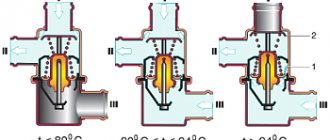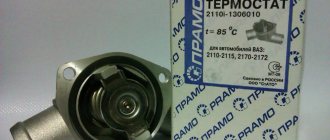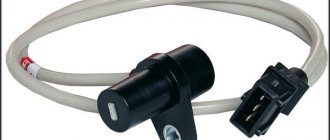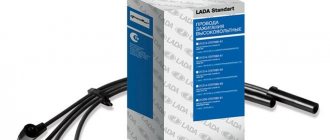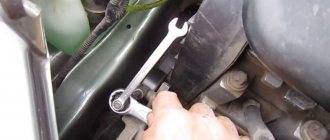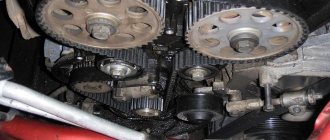Experienced car enthusiasts understand the principle of operation of the thermostat. Beginners have only heard about this part, but do not know what it is used for. Everyone encounters a thermostat sooner or later, since the unit changes with the same frequency as any other consumable. It lasts no more than three years, and its breakdown is difficult not to notice.
Characteristics of the Lada Kalina thermostat
The thermostat is an important engine cooling system; it occupies a place between the radiator and the cylinder block of the power unit. By design, this is a housing with an automatic valve, which, when the coolant is heated to a certain temperature, opens a large circulation circuit through the main cooling radiator. By closing the large circuit when the engine is cool, the car warms up much faster when circulating through the small circuit. The wear of its moving parts is reduced, overheating is eliminated, and the volume of harmful substances released into the environment is reduced.
A working thermostat allows you to warm up the engine to operating temperature, which for Kalina is 90-95 degrees. Over time, the valve wears out, and the heater maintains a temperature of no higher than 80 degrees. A working device helps the engine quickly warm up even in severe frost. Thanks to this device, the stove on Kalina is considered one of the warmest on VAZ cars. According to experts and car enthusiasts, the best price-quality ratio is the standard thermostat produced by DAAZ. It's all about a special screw, with which you can independently adjust the valve opening temperature. It is impossible not to take into account the reliability of factory products, which in this regard are superior to most analogues.
The same thermostats are used for 8- and 16-valve engines.
Basic data for monitoring, adjusting and maintaining the cooling system
| Temperature at which the main thermostat valve begins to open, °C | 85-89 |
| Full opening temperature of the main thermostat valve, °C | 102 |
| Opening pressure of the outlet valve of the expansion tank plug, kPa (bar) | 110-150 (1,1-1,5) |
| Opening pressure of the inlet valve of the expansion tank plug, kPa (bar) | 3-13 (0,1) |
| Coolant temperature in a warm engine at an ambient temperature of 20–30 °C and a fully loaded vehicle moving at a constant speed of 80 km/h, no more, °C | 95 |
| Resistance of additional resistor, Ohm | 0,23 |
| Volume of liquid in the engine cooling system, l | 7,8 |
| Coolant (mixing liquids of different brands is not allowed) | OZhK-KHT; OZh-40-ХТ; OZh-65-ХТ; OZH-K Antifreeze; OZh-40 Antifreeze; OZh-65 Antifreeze; OZh-40; OZh-65; OJK-KSK; OZh-40SK; OZh-65SK; Lada-A40; OZH-K Tosol-TS; OZh-40 Tosol-TS; OZh-65 Tosol-TS; Antifreeze G-48; AGIP Antifreeze Extra; GlysantinG03; GlysantinG913 |
How the device works
Photo 2 (Heater valve operation diagram)
Heater valve operation diagram
When the engine is cold, the thermostat valve is in the closed position, and antifreeze circulates in a small circle, passing only through the heater core and through the water jacket of the block. When the engine warms up to operating temperature, the valve opens completely and the liquid begins to circulate in a large circle, passing through the radiator, where it cools. This prevents overheating of the power unit.
In winter, warming up takes less time thanks to the thermostat - the heater radiator heats up earlier, and the cabin becomes warm within a few minutes, while saving fuel. The thermostat must be replaced if, when the temperature reaches 95 degrees or more, the valve does not open - the engine begins to overheat. If the motor, on the contrary, cannot warm up, it means that the device does not close and must also be replaced.
In design, this is a simple product consisting of a body, a main and bypass valve, a temperature-sensitive element, two inlet and one outlet pipe. Depending on the manufacturer, the thermostat is made of copper, brass or heat-resistant plastic. The heat-sensitive solid element is based on technical wax. When heated, it melts and, expanding, presses on the main valve, forcing it to open, thereby passing coolant in a large circle. The wax melts quickly thanks to the copper, aluminum and graphite powder that is included in its composition.
You can check the performance of the heater without installing it in the cooling system. To do this, place the device in a container of water and place it on the stove. As the liquid heats up, the thermostat valve opens approximately 3 centimeters. This way you can make sure that the device is working properly before installing it.
Why does air get into the Kalina cooling system?
How much antifreeze is in the cooling system of a VAZ-2110 with 8 or 16 valves
One of the benefits of buying a new car is that from the very beginning you can see, feel and remember how the car works when everything is working properly.
While the car is new and unusual, it is difficult to say what works correctly in it and what does not. After three to four thousand kilometers, a picture of a normally working machine automatically forms in your head. If something suddenly changes, I notice it immediately. This change does not always indicate a malfunction, but often it indicates its approach.
Something like this happened after about two years of operation.
Visible signs of trouble Typically, the temperature gauge arrow on the instrument panel did not reach the “90 degrees” mark by about 2 mm. Of course, in traffic jams it rose even higher. But when driving, the norm is a little less than 90.
At some point, the picture changed and the arrow began to show a little more than 90. I noted this fact. But there were no other signs of any malfunction.
It was autumn, winter was approaching. Soon I started turning on the stove and made an unpleasant discovery: it was barely heating. And after a couple of days, the murmur of antifreeze in the heater radiator began to be clearly heard...
I spent several days studying the Internet and hardware and now I can tell you the solution to this little puzzle.
The cooling system on the Kalina (and similar ones) has two design defects, due to which at a certain stage of the car’s life air begins to be sucked into it. While there is still not too much air, it slightly disrupts the circulation of the coolant. In order to maintain the heating-cooling balance, the thermostat raises the temperature of the antifreeze.
If nothing is done, air will continue to accumulate in the system and the heater radiator will become air-filled. It stops heating normally. Since she is in the cabin, you can hear “streams babbling” in her radiator.
Design defects:
1. The expansion tank is located below the antifreeze level in the engine.
2. There is no air valve in the expansion tank plug (or it is always inoperative), there is only an emergency pressure valve.
After stopping the engine, the antifreeze begins to cool and compress - a vacuum forms in the cooling system.
While the car is new, all rubber pipes are tightly connected to their fittings. The rubber of the pipes is still fresh and elastic. Therefore, they slightly compress under the influence of the vacuum generated inside and compensate for the change in the volume of antifreeze during cooling.
After two years of operation, the rubber becomes tanned and at the same time the pipes are pressed under the clamps, the connections begin to lose their former tightness. As a result, when the engine cools down, air begins to be sucked through them. It gradually accumulates and - read above what happens.
The simplest "treatment"
1. Tighten all clamps.
2. After the trip, let the engine cool slightly and unscrew the expansion tank cap so that air can flow freely into the system.
You can park the car with the left wheels on the sidewalk a couple more times to help the air pockets escape into the expansion tank.
With an 80% probability, all air pockets will come out on their own and the temperature gauge will again show just under 90.
Try this trick. Just don’t forget to tighten the cork properly the next day!
Thermostat malfunctions
The thermostat is a consumable item, which means it cannot be repaired. You can carry out the replacement yourself or contact a car service center with this question. In the first case, only the cost of the device itself will be included in the costs. When contacting specialists, about 400 rubles will be added to this amount for the work of a car mechanic. The part is changed because there is nothing to repair in it. The most common malfunction is the failure of a solid-state temperature-sensitive element.
The thermostat on the Lada Kalina is located in the cooling system circuit between the radiator and the engine block - immediately below the air filter. It is enough to move it aside to see the device.
Before changing the thermostat or checking its performance, you need to know what malfunctions are typical for it. There are three signs that indicate a breakdown:
- The valve is stuck open. In this case, the coolant always circulates in a large circle, even when starting a cold engine. It takes much longer for the engine to warm up to operating temperature. In the summer, such a breakdown does not bring any inconvenience to the car owner, but with the onset of cold weather the engine may not warm up at all. The stove will not work as expected and fuel consumption will increase.
- The valve is stuck in the closed position. If the device cannot open, then the coolant circulates only in a small circle. The engine will constantly overheat, and there will be a risk of complete failure. Long-term operation of the vehicle with such a malfunction is prohibited. To prevent overheating, you can turn on the heater fan at maximum blowing speed and constantly monitor the engine temperature gauge.
- The valve opens earlier than it should. When the valve opens at a temperature of 70-75 degrees, the engine does not have time to warm up to operating temperature and spends more time and fuel on this.
The latter problem occurs rarely - mainly on devices that are not suitable for use on this car or are made in a homemade way.
Causes of malfunctions and ways to identify them
The most common problems:
- the appearance of corrosion on the moving elements of the device is rare, mainly when tap water is used instead of antifreeze;
- foreign objects entering the housing, contamination or scale formation;
- low quality antifreeze;
- Coolant pump malfunction.
What he really is?
This is a part that plays a big role in the supply of coolant so that the engine does not overheat and its main function is not impaired. During the cold season, due to external factors, the surface of the machine is cooled to very low levels. The thermostat comes to the rescue: it normalizes it, closing the valve flap and allowing the temperature to rise to the designated level.
The 8-valve Lada Kalina is equipped with a coolant controller, which is not electronic. The unit operates on the laws of physics. These conditions simplify the task for car enthusiasts, because not all car owners understand the principle of operation of the electronics in the car.
It is easy to understand the functionality and operation of the device - inside there is a heat-sensitive part that is triggered when heated, gradually starting to melt. This process provokes the opening of the valve flap, through which the coolant enters the large circle.
How can you modify the heater?
The new models Lada Kalina 2 and Lada Granta use a cooling system operating scheme with parallel connection of the heater radiator. Because of this, the operating temperature is reduced to 85 degrees, which is slightly lower than on previous models of the VAZ family. Many car owners seriously believe that this temperature cannot be normal - there is increased fuel consumption, as well as a decrease in the service life of moving engine parts due to premature wear. But according to experts, there is no connection between the reduced operating temperature and engine life.
The cooling system of the Lada Kalina works more efficiently thanks to a single-circuit design. Such a modernization only benefited the engine; it made it possible to change the ignition timing, resulting in fuel savings. The inertia of the thermostat is also reduced. The downside was the mediocre heating of the cabin at sub-zero temperatures. The way out of the situation is to independently modify the thermostat. Modification involves two main methods:
- shorten the rod of the solid-state temperature-sensitive element;
- replace the thermocouple.
For cars with a cable gas pedal, a heated throttle assembly from the cooling system is used. In this case, an additional circulation circle is added.
Adjusting the thermocouple rod
Shortening the end of the thermosensitive element rod will allow you to adjust the operating temperature to 90-95 degrees. Trimming is carried out sequentially in increments of no more than one millimeter. The metal is soft, so the procedure must be carried out carefully. It is advisable to reinstall the thermostat after each millimeter cut and check how much the operating temperature rises while driving.
If the result does not meet expectations, you can adjust the rod further until the arrow on the instrument panel shows 95 degrees and the air in the cabin begins to warm up faster. The method is simple but effective. Among the disadvantages, there is a slight increase in wear of SOD parts due to operation at high temperatures. If you overdo it with shortening, you can ruin the device.
Replacing the temperature sensor
The thermocouple can be replaced entirely. The Wahler brand thermostat insert is suitable for Lada Kalina: 3017.87 D (at 87° C) or 3091.92 B (at 90° C). The thermoelement is replaced as an assembly with a spring, and the device will have to be cut with a hacksaw to remove the insert. A more convenient option is to buy a thermostat from BEHR - you don’t have to cut or adjust anything
You can also use analogues from Daewoo Nexia or Renault Logan cars. Logan's thermal insert requires adjustment.
If a LUZAR thermostat is installed on Grant, then replacing the temperature-sensitive element is not possible.
Judging by the reviews of car owners who have made such modifications, fuel consumption while warming up the engine has decreased slightly.
Throttle body heating
Another way to upgrade the heater is to create an additional throttle valve heating circuit. Some drivers are trying to prevent the unit from freezing in winter in this way. The method is clearly not for beginners. It consists of drilling a hole in the cover of the device and welding an additional fitting to it, through which heated antifreeze will be discharged. The thermostat mounting studs will also have to be lengthened. The process is labor-intensive and ultimately impractical. Freezing of the throttle assembly is the exception rather than the rule, so there is no point in carrying out such an upgrade.
Improved cooling of VAZ-1118 “Kalina”
To reduce the likelihood of airing of the SOD due to jamming of the compensation valve of the expansion tank cap, readers suggested removing the valve from it as a temporary measure. We cannot recommend this method, because the risk of boiling and overheating of the engine increases. But if you decide to go this route, in order to prevent the antifreeze from boiling away at atmospheric pressure, we lower the fan start temperature to 98 degrees programmatically, or we cut an adapter into the radiator inlet pipe for sensor .
A more correct upgrade option has been tested several times and has shown its performance on cars with a cable-operated throttle. We put a plug in the pipe connecting the large cooling circle to the expansion tank;
- We connect the freed fitting to the lower heater hose through the tee from 2110;
- We plug the thin outlet hose (distant, if you look from the front of the car) of the throttle heating.
- We connect the free fitting through a tube of the appropriate diameter to the expansion tank. To do this, we cut an additional nipple into the upper plane, or connect through a tee to a thin input. Thus, we transfer the steam outlet to a small circle, while taking the liquid with air bubbles at the top point of the system.
Thus, we transfer the steam outlet to a small circle, while taking the liquid with air bubbles at the top point of the system. On a car with an electronic pedal (e-gas), we do the same.
- We connect the thin fitting of the thermostat to the upper part of the expansion tank (via a tee or an additional fitting). We turn off the standard thin tube from the thermostat.
- Disconnect and turn off the lower extension hose. tank, in the vacant space we connect a homemade line from a tee embedded in the “return” of the heater.
Replacing the thermostat
On the automotive spare parts market you can find a large number of thermostats from various manufacturers; their cost varies from 400 to 700 rubles. When choosing, it is better to stick to original AvtoVAZ spare parts. The catalog number for the standard thermostat on Kalina is 1118-1306010. Of the analogues, “Luzar” and “Pramo” have proven themselves well, but the first is often counterfeited, and the second has poor quality - the service life is on average about a year. The original device, which is installed from the factory, can last more than three years. Replacing a thermostat on Kalina with 8 valves or 16 is estimated at no more than 800 rubles, including removing air from the system. To avoid paying twice, you can change the part yourself. Just before this, you should check the device for functionality using the described methods.
What tools will you need?
To operate, you will need a working thermostat and a suitable container for draining the coolant from the SOD - a regular five-liter plastic bottle. The differences between replacements on an 8- and 16-valve engine are insignificant. On the latter, you will need to additionally remove the starter so as not to accidentally fill it with antifreeze. The rest of the procedure is similar.
Thermostat malfunctions
The design of the thermostat consists of a housing with pipes and a sensitive element with a valve, which actually shuts off the pipeline. The housing itself fails extremely rarely, and only due to mechanical damage.
Most often the sensitive element breaks. It is a sealed cylinder filled with a wax-based solid. The cylinder contains a piston with a rod. When heated, the substance melts and expands, pushing the piston. The latter extends and closes the valve.
The most common reasons for thermostat failure are:
- deposits of products of corrosion processes on the moving parts of the sensitive element;
- dirt, scale or foreign objects entering the thermostat housing;
- poor quality coolant;
- malfunction of the water pump (pump).
One symptom of a faulty thermostat is an overheating engine. It indicates that the coolant (coolant) moves in a small circle without passing through the radiator. It can also happen the other way around, when the liquid moves constantly in a large circle. In this case, the engine will take a very long time to warm up.
Thermostat device VAZ 2114
Regardless of which engines were installed on the ninth-14th family, the thermostat was the same. The exact same one was installed on both the Oka and the 2115, and the difference with the thermostat from the VAZ 2110 is only in the coolant circulation circuit. This scheme, by the way, is more suitable for cold regions than the nine one, but more on that later. The thermostat is a thermal valve in a housing with four pipes.
The valve, thanks to the thermocouple, can open at a temperature of about 80°C. This makes it possible to divide the car’s cooling system into two circuits - large and small. The small circuit does not include a cooling radiator and should be used in the cold season to quickly warm up the engine.
Verification methods
There are two ways to determine the functionality of the thermostat. The first method involves checking without dismantling. To do this, you need to start a cold engine, warm it up to operating temperature (about 90 degrees), and touch the lower radiator hose.
A cold lower pipe at this temperature indicates that for some reason the thermostat did not open. If it is hot, the thermostat operates normally.
For a more accurate check, you will need to remove the thermostat cover with the sensitive element. Place it in a metal container with clean cold water and place it on the stove to warm up. When the water temperature reaches 85-90 degrees, the element should operate, pushing the valve stem forward. If this does not happen, the thermostat is faulty.
How to tell if the thermostat is working correctly
In order to find out whether the thermostat is working or not, it is necessary to warm up the engine so that the arrow indicating the temperature does not reach the red mark of the indicator quite a bit.
After that, turn off the engine, go to the hood and open it, look for the upper radiator hose. This rubber hose is usually black in color and is approximately 5cm in diameter.
There are metal clamps at its ends. The upper hose is attached to the top of the radiator. Then we look for the lower hose. It looks like the top one, only it is attached to the bottom of the radiator.
Touch the hoses carefully; they may be hot enough to burn you. If the engine temperature indicator shows that the engine is hot, but one of the hoses is cold, then most likely the thermostat valve is closed and is not allowing coolant through the radiator.
In this case, replace the old thermostat with a new one as quickly as possible (after waiting until the engine has cooled down).
There is another “folk” method for checking the functionality of the thermostat and it is as follows. Place the thermostat in a vessel with boiled (temperature should be about 100 degrees) water.
Next, we visually observe whether the thermostat valve opens. If it opens, it means it’s working. If not, we replace the damaged one with a new one. The above method involves removing the thermostat from the car.
If the thermostat malfunctions in a car, overheating or, more often, low engine temperature is observed. Such phenomena are associated with the thermostat jamming in one position; as a result, the coolant moves in one circle (large or small). Lack of adjustment of coolant distribution leads to deviations from the engine temperature regime. Thermostat failure is one of the most common problems in a cooling system. To replace the thermostat on a Lada Granta car, the coolant from the cooling system does not need to be completely drained.
You will need: TORX TZO wrench, 13mm socket, Phillips-blade screwdriver.
Thermostat price
The approximate price of a thermostat cover with a sensitive element in our stores is 450 - 700 rubles . When choosing a spare part, it is better to give preference to branded VAZ models. The catalog number of the Lada Kalina thermostat is 1118-1306010.
The cost of replacing this unit ranges from 500-800 rubles.
In order not to overpay for the work, you can replace the thermostat yourself, but before that, do not forget to check it using the method described above with heating water.
Features of replacing the thermostat on Kalina
How to replace a thermostat? To successfully implement the indicated procedure, the owner will need to adhere to the steps below.
- First, disconnect the connector of the sensor connected to the intake air tract filter element unit.
- To ensure better convenience, we recommend that you completely remove the air filter housing from the engine compartment. It is held in place by three fastening points, 2 of which are based on elastic bands, and the third is located in the battery area.
- Before draining the antifreeze from the cooling circuit, we determine how to carry out this manipulation. Here we highlight two of the most convenient methods.
- The first method is a procedure that allows you to perform a drain using a conventional air compressor used to inflate tires. This option eliminates the need for a pit or lift, and the work itself can be done in any suitable location. Now you know how to change it, but let’s add that the undeniable advantage of this method is that there is no need to remove the pipes and unscrew the plugs located on the engine block and radiator.
- Before the procedure, we stock up on an empty container, the capacity of which is equivalent to 4-6 liters of liquid, as well as directly on the compressor with the device.
- Open the cap on the expansion tank, from which we also remove a small diameter hose. We seal the “bare” tank fitting with adhesive tape.
- We place this hose in a pre-prepared container and hold it securely inside the container.
- The hose leading from the discharge pipe of the compressor unit is inserted into the hole in the expansion tank (sealed).
- By briefly turning on the compressor, we force compressed air to penetrate into the system. Air displaces liquid from the circuit, and it flows into the container.
- We carry out the procedure until the antifreeze is completely removed from the LADA Kalina system.
- The second common method is to drain through open plugs on the radiator and engine block.
- For this purpose, we also prepare a suitable container and, using the indicated manipulations, completely drain the liquid. Don't forget to screw the plugs back in.
- Now, using a convenient screwdriver, we loosen the fasteners of all pipes suitable for the thermostat and then remove them.
- To dismantle the thermostat itself, we arm ourselves with a hex key, size “5”, and unscrew the 3 screws.
- If, after unscrewing, the unit does not “want” to be disconnected from the lines, then using the same screwdriver, we loosen it, running the tip between the adjacent surfaces.
- We clean the mating sections of the main pipes with the LADA Kalina thermostat from scale formations and at the same time replace the sealing gaskets.
- We install the new product in its original place, tightening the bolts securely.
- After this, we connect all the dismantled pipes to their original places, not forgetting to tighten the fastening clamps.
- We check the reliability of the screwed plugs and fill the system with antifreeze. We do this through the neck in the expansion tank of LADA Kalina.
- In some cases, it will be convenient to replace the thermostat along the way if its service life suggests this action or is approaching such a need.
- Upon completion of filling, install the housing with the air filter and connect the previously disconnected sensor. Now you know how to change the thermostat in your car, so replacing the thermostat will not be too difficult for you.
Management
We bring to your attention detailed instructions for completely replacing the thermostat with a new one. Even if you don’t understand how to replace the thermostat on a viburnum, the video will help clarify the situation.
1. Disconnect the sensor from the air filter housing and remove the air filter. As a rule, it will take no more than ten minutes to dismantle it. This is done correctly like this:
- completely unscrew the 2 screws located on top, as well as the nut located on the side of the engine compartment. We recommend leaving these parts in one place so that later you don’t have to look for them separately on the market;
- remove the connector installed on the recirculation valve (it, in turn, is based on the filter housing);
- lift the valve up, and then, without disconnecting the tubes, move it all to the free side;
- by unplugging the plug from the air sensor, remove the air hose by loosening the clamp;
- Having slightly loosened and turned the air filter housing, it should come out.
3. Take a 8mm socket wrench and a screwdriver. Use it to loosen the clamps , and then remove the four hoses.
A well-pumped system will not allow liquid to spill in large quantities.
4. Take a 12mm wrench and remove the wire by unscrewing the top nut on the thermostat.
5. Now take the key for 13. There is a nut and a stud on the thermostat - you will find the first in the upper part of the housing, the second at the bottom. Try to remove the thermostat by gently loosening it.
Helpful advice: loosen the thermostat carefully, sometimes helping yourself with a screwdriver.
These actions must be performed because during operation, high temperatures literally “solder” the thermostat, causing the housing to stick. Help with a screwdriver will solve this problem.
6. Next, clean the seat from accumulated dirt (there will be a lot of it there). Don't leave the old gasket in place - get rid of it completely. Wipe the seating areas with a clean cloth. Using sealant, 1-1.5 mm of substance per seat, or use a paper gasket. The best option at the moment is sealant. If you have applied it, stop working for 5-10 minutes. During this time, the sealant needs to crystallize. In the case of a paper gasket, work can be carried out immediately.
7. Installation of a new thermostat is carried out in the exact opposite order of removal. It is important not to forget to replace the temperature sensor from the old thermostat. It is also important to connect the ground wire. This is done by screwing the ground wire onto the top stud.
8. After all hoses are reconnected, add coolant to the system . Its quantity can be selected based on how much liquid you drained during disassembly of the old faulty device. To accomplish this task, the method of removing air pockets is used.
In test mode, start the engine. While it is idling, make sure that all hose attachment points are not leaking . If such a problem occurs, tighten the loose clamps.
Important points when replacing a thermostat
When replacing the thermostat, eliminate the risk of antifreeze getting onto the sensor connectors and into the air path of the Lada Kalina. To prevent such situations, we recommend wrapping electrical connectors and components in plastic bags. Due to the low cost of the thermostat, a more rational action would be to replace the entire thermostat. It is better to purchase original products, since analogues may not match their fastening characteristics (hole diameters, etc.). This will avoid difficult moments during installation.
Checking for correct installation
It is very easy to check the correct installation and operation of the thermostat in the Lada Kalina. Here you will need to warm up the engine and then immediately turn it off. Next, open the hood and feel for the lower pipe that goes from the radiator to the cooling jacket of the engine block. If it is heated, the thermostat opens, and there is no risk of the Lada Kalina engine overheating. When this phenomenon does not occur, the system components require careful diagnosis. Therefore, it would be a good idea to check the functionality of the new thermostat before installation.
